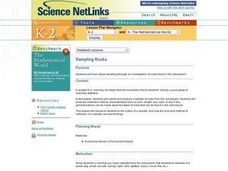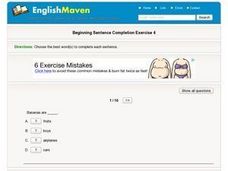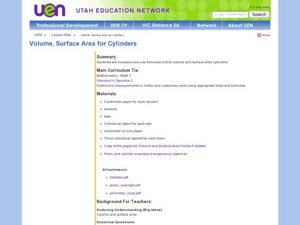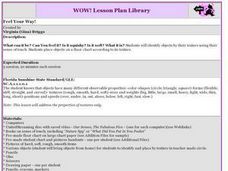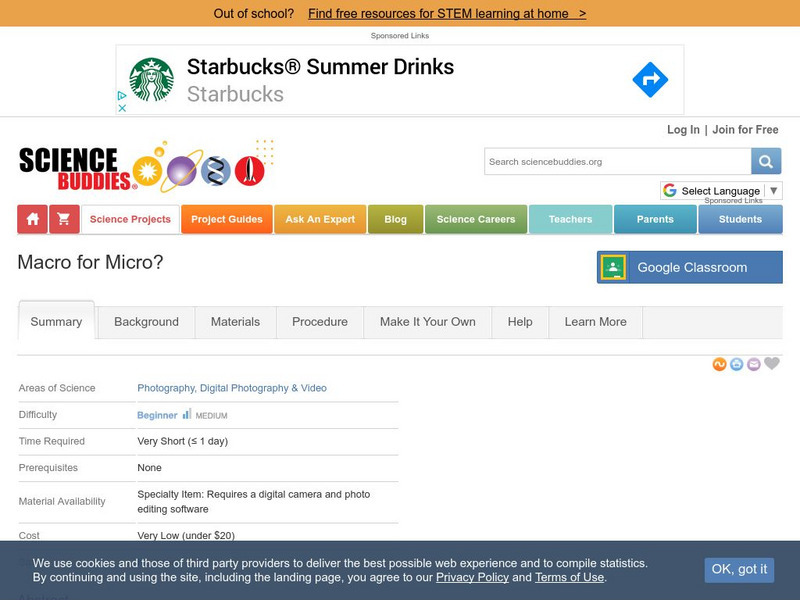Curated OER
Oobleck
First graders explore Oobleck. They manipulate and observe the properties of Oobleck. Students discuss the differences between solids and liquids. They investigate Oobleck. Students write a sentence describing what they observed about...
Curated OER
Charting The Planets
Students conduct different activities in order to unlock the secrets of the universe. They answer different questions that are written to assess knowledge of the planets. Information can be found on the internet to help.
Curated OER
Motion of a Bowling Ball
Students experiment with distance, speed, and motion by graphing the motion of a bowling ball. In this distance versus time graphing lesson plan, students observe the speed and distance of a rolling ball and graph their findings. They...
Curated OER
Solar System Cloze Activity
In this solar system worksheet, students fill in 21 blanks with words from a word bank at the top of the page. They include information about the solar system, terrestrial planets, gaseous planets, and planetoids.
Curated OER
Lesson Nine: Size and Scale
Young scholars investigate scale as it is related to maps. In this map instructional activity, students read Jack and the Beanstalk by Carol North. Young scholars then compare the setting in the story to a landscape picture map to help...
Curated OER
Sampling Rocks
Students analyze rocks. In this rock classification lesson, students collect and analyze rocks that they find on the school premises. Students classify the rocks according to their physical characteristics in order to create a rock guide.
Curated OER
Beginning Sentence Completion 4
In this sentence completion worksheet, learners complete the sentences by choosing the best words to complete them. Students complete 12 sentences.
Curated OER
Back to the Future
Learners imagine what it would be like to travel back in time. For this creative writing lesson, students watch parts of the film Back to the Future and examine artifacts from the past. Learners write a short story in which they travel...
Curated OER
Let's Build
Students listen as the teacher differentiates between natural and people-made items. They go outside and make lists of natural and people-made things they see. Students complete the linked worksheet by cutting and pasting as suggested by...
Curated OER
Make a Dinosaur
Students estimate the size of dinosaurs and create a dinosaur model. They create bar graphs of the sizes of dinosaurs one in meters and the other in "student" units. They draw a pictures and add words or sentences about their dinosaur.
Curated OER
The Vocabulary of Space
Learners build their knowledge and understanding of vocabulary related to space. For this space lesson, students discuss four categories of words and phrases related to space.
Curated OER
Model Community
Students explore what it means to create miniature models, and apply what they create a miniature version of their local community for a class exhibit. They write artist statements explaining their models.
Curated OER
Insects
Students, through books, videos, and readings, explore characteristics of insects. In groups, they choose an insect to research. Students discover their insect's diet, how they move, and where they live. Afterwards, they use the facts...
Curated OER
Making Fudge: Measuring Weight
Fourth graders measure the ingredients for a fudge recipe. In this measurement lesson, 4th graders practice measuring out the ingredients for a recipe to make fudge. Later, students get to enjoy the fudge they made.
Curated OER
Demonstrate the Law of Conservation of Linear Momentum
Learners observe a demonstration of linear momentum. In this linear momentum lesson, students observe a series of demonstrations of linear momentum and qualitative observations.
Curated OER
Volume, Surface Area for Cylinders
Seventh graders explore the concept of volume and surface area of cylinders. In this volume and surface area of cylinders lesson, 7th graders break cylinders into their base shapes of a circle and a rectangle. Students discover that...
Curated OER
Transitive and Intrasitive Verbs
In this transitive and intransitive verb worksheet, students identify transitive and intransitive verbs. Students are given a sentence pair and must click "yes" or "no" in the transitive and intransitive columns to show...
Curated OER
Jumping Numbers
Students practice jumping with a two foot take-off and a two foot landing using the given cues.
Curated OER
Sampling Rocks
Learners will collect and analyze a sample of rocks from the schoolyard. They will array the collected rocks by characteristics such as size, weight, and color, to see if any generalizations can be made about the types of rocks that can...
Curated OER
Feel Your Way!
Young scholars investigate the sense of touch as they examine the texture of items in the classroom and from their homes. They watch a computer based video about the senses and draw items that are rough, smooth, soft, and hard.
Curated OER
Hip-Hop
Young scholars practice letter recognition. They say tongue-twisters with the practiced sound. Students read a book about the sound. Using laminated picture cards, young scholars pant when they see a word with the sound.
Science Buddies
Science Buddies: Small, Tiny, Invisible: How Big Is a Virus?
How big or small are viruses really? In this activity, you will find out by creating a scale model that allows you to compare the size of many different small objects.
Smithsonian Institution
National Museum of African Art: Big and Small Are Tricky
An exhibition that uses African art to explain the concepts of bigness and smallness. In the world of art, big and small can refer not only to physical size but to relative size, to the impression an object makes, or to the largeness of...
Science Buddies
Science Buddies: Macro for Micro?
If the prefix "macro" means large and "micro" means small, then why will the macro setting of a digital camera help take a better picture of a small object? Do this experiment and get the big picture.







